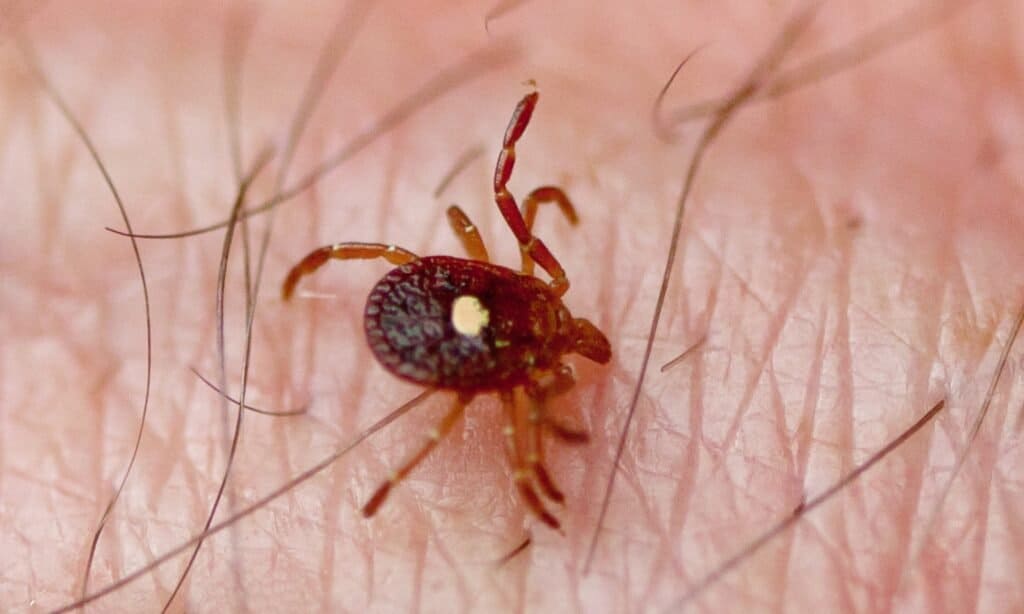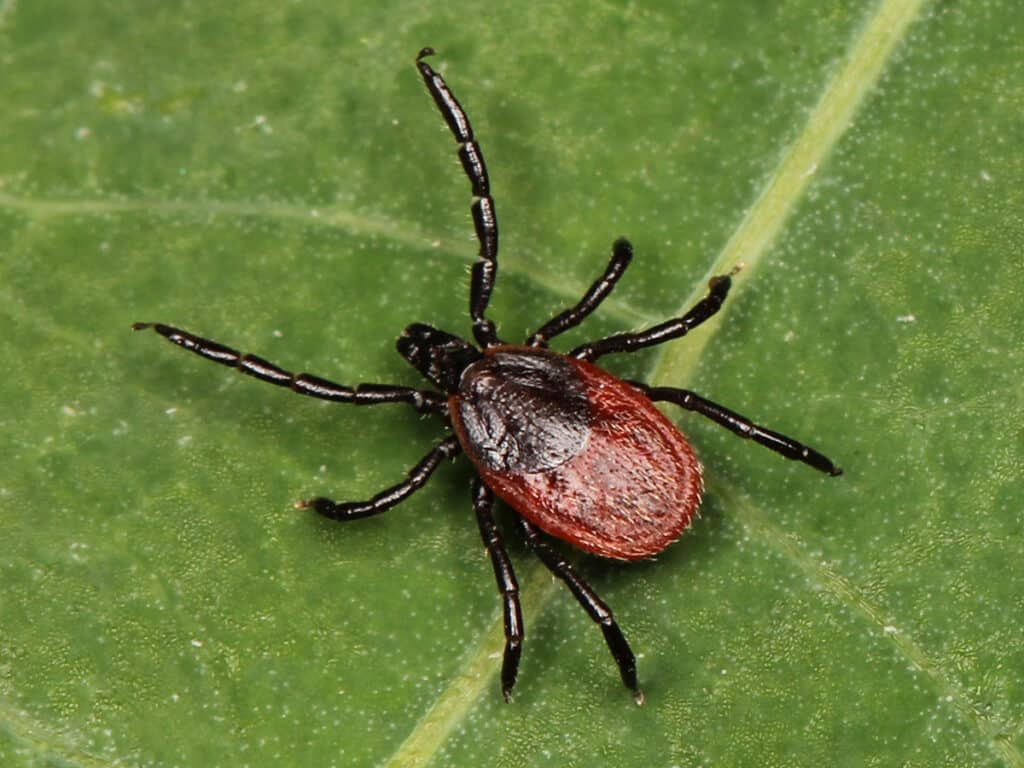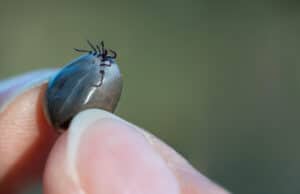It is no secret that ticks are among the animals that humans dislike the most. After all, how could you blame us? These parasitic creatures survive by consuming our blood and that of other animals. Additionally, they are known to spread a wide variety of terrible diseases. Ticks, however, have actually existed on the planet for longer than humans.
The oldest fossil tick, which was found in New Jersey amber, is 90 million years old. They first appeared in the Cretaceous Period (between 66 and 145 million years ago). Ticks, despite their age, are an irritating nuisance many of us would like to avoid. So, have you ever wondered how ticks get on you?
Discover how ticks get onto our bodies and how you can prevent them from doing so.
What Are Ticks? A Quick Rundown on These Parasitic Arachnids

Ticks are not actually insects but are classified as arachnids.
©iStock.com/epantha
The first thing we need to understand about ticks is what they are. There is a common misconception that ticks are insects. However, they are not considered insects. As a matter of fact, they are actually arachnids. In other words, they are more closely related to spiders, scorpions, and mites from a biological perspective. In fact, when you look closely at a tick, its four pairs of legs and lack of antennae make it look like a spider.
The number of species of ticks is estimated to be around 900. The number of species of ticks is estimated to be around 900. There are many different types of ticks, including the lone star tick that is native to the eastern United States and Mexico. Most people know this tick for causing the alpha-gal syndrome, a red meat allergy.
In addition, they are parasitic creatures by nature. The survival of ticks depends on blood meals. As a result, they must latch onto an animal in order to drink its blood. For a really good meal, they stay on for quite a while after attaching themselves. As a result, many people begin to wonder how they get on them. What is the exact way these blood suckers detect their next meal, and how do they find their way onto you and other animals? Let’s find out!
How Do Ticks Get On You?

Ticks locate their host by smelling their odor and sensing their body vibrations.
©iStock.com/epantha
The tick locates its host by smelling breath or body odor or by sensing its heat, moisture, and vibration. There are some species that can even recognize shadows.
Ticks identify the best places to wait by following well-worn paths. After that, they rest on the tips of grasses and shrubs, waiting for a host. Flying and jumping are impossible for them. However, many species of ticks wait in a position called the questing position. It is the third and fourth pairs of legs that allow them to cling to leaves and grass. Their first pair of legs are outstretched, awaiting the opportunity to attach themselves to the host. As soon as a host brushes the area where a tick is waiting, they will then immediately climb onto the host. It is common for them to attach themselves to a host very quickly. There are, however, some that wander around looking for areas with thinner skin, like the ear or other sensitive areas.
It is likely you are wondering what can be done to prevent ticks from getting on you easily now that you know how they get on you. Despite their small size and difficulty in spotting, there are ways to prevent getting bitten by ticks. Let’s find out the best way to prevent a tick from getting on you!
How To Prevent Ticks From Getting on You
There is a common misconception that ticks are only found in forests. Depending on the surroundings, they can also be found in yards, especially if they are near wooded areas. As a result, it is important to always stay alert and take precautions when you go outside.
You can take several precautions to prevent ticks from getting on you.
Best Precautions To Avoid Ticks Getting on You
- Keep your socks tucked into your shoes/boots: Although ticks are often assumed to be atop trees or other high areas, they are actually found more commonly in tall grass than trees. As a result, many of them will attach themselves to your ankles. For that reason, you should keep this part of your skin hidden.
- Use permethrin on your clothes: Clothing treated with permethrin may help prevent ticks. During a two-year study conducted in Rhode Island and Massachusetts in 2020, 40 workers wearing permethrin-treated clothing had 60 tick bites, while 42 workers without treated clothing had 166 bites. Permethrin spray should only be used on clothing and gear, and your skin shouldn’t be exposed to it.
- It is recommended that you wear darker clothing when hiking: It has been found that ticks are more likely to attack you if you wear lighter-colored clothing. Identifying ticks is easier if you wear light-colored clothing, but darker colors tend to attract fewer ticks.
- It is recommended to use insect repellents registered with the Environmental Protection Agency (EPA): Several repellents can be used to repel ticks, including DEET, picaridin, and IR3535. You may also want to look into the Oil of Lemon Eucalyptus, para-menthane-diol, or 2-undecanoate. If your child is under 3 years old, do not use any products that contain OLE or PMD.
- If you have been outdoors, check for ticks on your body: There are many types of ticks, but the deer ticks (the type that spreads Lyme disease) are so small that they are very difficult to detect. This species can stay attached for up to three days, and they prefer to hide in moist, dark crevices, such as the hairline, the underarms, the groin, the ankles, and behind the knees in particular.
What Diseases Do Ticks Carry?

One of the most common diseases spread by ticks is Lyme disease.
©Kaldari / Creative Commons – License
Humans can be infected with tick-borne pathogens by being bitten by infected ticks. The tick cuts into the skin when it finds a good feeding spot. As a result, they can feed for a long period, unlike most other small insects that bite. For days on end, they can feed securely attached to a host by burying their teeth deeply into its skin.
Tick-borne pathogens can be passed to humans by the bite of infected ticks. An infected tick may carry bacterial, viral, or parasitic diseases.
The following are some of the most common diseases transmitted by ticks in the United States:
Lyme disease
In most cases, Borrelia burgdorferi causes the disease, but Borrelia mayonii can also cause it. Infected black-legged ticks transmit the disease to humans through their bites. The most common symptoms of this disease include fever, headache, fatigue, and erythema migrans, which is a characteristic skin rash.
Babesiosis
Babesiosis is an infection among red blood cells that is caused by microscopic parasites that are transmitted by ticks.
Rocky Mountain Spotted Fever
This disease is caused by tick bites infected with bacteria from the rickettsia family. Fever, headaches, and muscle aches are some of the symptoms.
Southern Tick-Associated Rash Illness
This bacterial disease is transmitted to humans by deer ticks. The rash is akin to one caused by Lyme disease and is caused by a tick called the lone star tick. In addition to an expanding rash, STARI is also associated with mild symptoms like fever, malaise, and headaches.
Additionally, these parasitic arachnids are responsible for Powassan encephalitis, Colorado tick fever, and Q fever. In the United States, Lyme disease causes more cases than any other tick-borne disease. A tick-borne disease can cause mild symptoms that can be treated at home or severe infections that require hospitalization. It is, however, possible to reduce the risk of serious complications if the infection is recognized and treated early. A bite from one of these arachnids can cause symptoms such as fever and a rash, so you should see your doctor right away if you experience any of these.
The photo featured at the top of this post is © Tomasz Klejdysz/Shutterstock.com
Thank you for reading! Have some feedback for us? Contact the AZ Animals editorial team.






